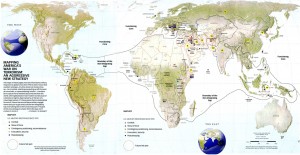While 13 years may have passed since September 11, 2001, Islamophobic sentiments in the United States remain as aggravated a problem as ever. This is most evident in a poll conducted by the Arab American Institute (AAI) regarding “American attitudes toward Arabs and Muslims.” James Zogby, AAI President and author of “Arab Voices,” reports that the results are “deeply troubling.” In suggesting a comparison of this year’s results to those of 2010, Zogby finds that positive attitudes towards Arabs have declined from 43 percent to 32 percent while positive attitudes towards Muslims have dropped from 36 percent to 27 percent. Within the greater context of Islamophobia in the United States, treatment of Islamic women is especially problematic. The oppression of women under radical Islamic regimes has been used as a rationale for foreign intervention, and yet the women’s rights movements that exist despite said regimes are rarely discussed.
While perceived as a grand claim by some, Zogby’s hypothesis is consistently bolstered, most recently by the assault on Arab civil rights activist and director of the AAI branch in New York Linda Sarsour. Sarsour was attacked by Brian Boshell, a white male, who called Sarsour an “Arab bitch” and suggested that he might behead her to “see how your people feel about it” before hurling a trash can at a woman accompanying Sarsour. Although Boshell was inebriated at the time and cannot aptly represent US sentiments as a whole, the fraught dynamic of the above incident must not be overlooked. The brown woman has forever been a symbol of the American fight against terrorism as feminist issues have historically been part of the justification of American foreign policy decisions in the Middle East.
On November 21, 2001, then-First Lady Laura Bush addressed the nation in a radio correspondence. Undoubtedly a ploy to garner public support for the War on Terror, her speech conflated the American bombing campaign with the fight for women’s rights in Afghanistan so that listeners might feel even more inclined to be on “the side of America,” which now oppressed Afghan women. According to Bush, “because of our recent military gains in much of Afghanistan, women are no longer imprisoned in their homes. They can listen to music and teach their daughters without fear of punishment. The fight against terrorism is also a fight for the rights and dignity of women.”
Earlier that day, the US State Department released “The Taliban’s War Against Women,” a report summarizing the rights and freedoms enjoyed by women before Taliban takeover. The State Department cited the Taliban as chief violators of women’s rights in Afghanistan and highlighted the group as a target to be eliminated, if only for the protection of women. While this is not entirely untrue, a crucial piece of the story was left untold. The Taliban, undoubtedly guilty of egregious violations of human rights, bears an uncanny resemblance to the Mujahedeen — a radical group that the United States backed in the summer of 1979 in hopes of thwarting Soviet efforts during the Cold War. An objective analysis of female oppression in Afghanistan traces back to the beginning of Mujahedeen rule, which flourished primarily because of US aid.
Historical analyses will demonstrate that Afghan women were fairly liberated at the hands of male monarchs for approximately 50 years beginning in 1880 and again from 1933 to 1978. During these periods, several significant strides were made on behalf of women’s liberation. The first secondary school for females was established in the capital, Kabul. Women could be seen in the public sphere without veil or other covering. In 1964, women were given the right to vote. The Democratic Organization of Afghan Women was formed in 1965 and worked towards increasing female literacy and banning forced marriages and dowries. In 1972, the first Miss Afghanistan pageant was held. Meena Keshwar Kamal formed the Revolutionary Association of the Women of Afghanistan (RAWA) in 1977 in hopes of reaching a more secular and democratic government.

The idea that women in conservative Islamic states have to be ‘educated’ about their rights is, in many cases, misplaced. In surveys completed by Physicians for Human Rights, more than 95% percent of Afghan women agreed that women should be granted equal access to education, equal work opportunities, freedom of expression, freedom of association, freedom of movement, control over the number and spacing of children, legal protection for women’s human rights and participation in the government. More than 95 percent also disagreed with Taliban dress codes and believed that the teachings of Islam do not inherently impose restrictions on women’s human rights.
Islamophobia — indisputably present in the United States as made evident by AAI’s poll — has always been a gendered issue but rarely seems to be analyzed within this particular framework. Muslim women have long been victims in the minds of Americans, but this does not mean that greater attitudes towards them are any less problematic. Although traditional Muslim societies indisputably maintain prejudices towards women, progress has clearly been made and Muslim women have been able to defend their rights and impact their communities in important ways. Nevertheless, the portrayal of Arab women as weak and powerless remains a staple in both the US media and in its foreign policy.
